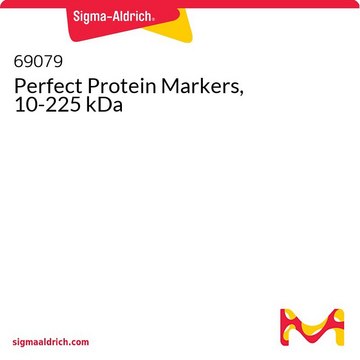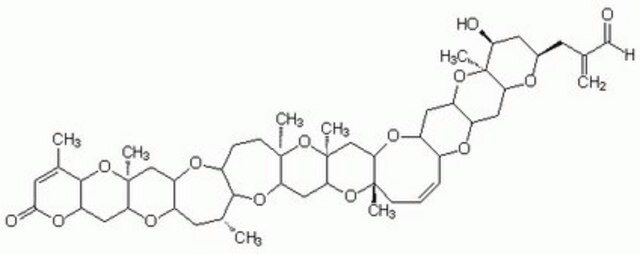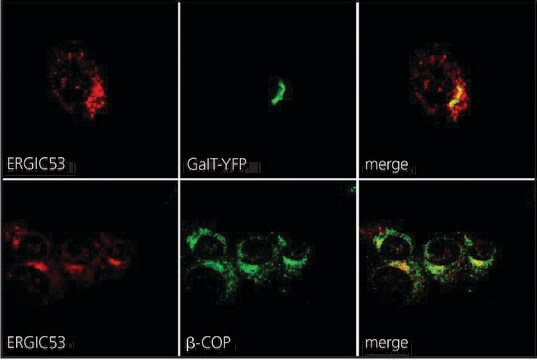03-108
RIPAb+ Fragile X Mental Retardation Protein - RIP Validated Antibody and Primer Set
from mouse
Synonyme(s) :
Fragile X mental retardation 1 protein
About This Item
Produits recommandés
Source biologique
mouse
Niveau de qualité
Clone
monoclonal
Espèces réactives
human, rat, mouse
Fabricant/nom de marque
RIPAb+
Upstate®
Technique(s)
ELISA: suitable
RIP: suitable
immunocytochemistry: suitable
immunohistochemistry (formalin-fixed, paraffin-embedded sections): suitable
immunoprecipitation (IP): suitable
western blot: suitable
Isotype
IgG1κ
Numéro d'accès NCBI
Numéro d'accès UniProt
Conditions d'expédition
dry ice
Description générale
Spécificité
Immunogène
Application
Representative lot data.
Mouse E17 spinal cord lysate (Lane 1), Mouse E16 brain (Lane 2) and NIH/3T3 lysate (Lane 3) were resolved by electrophoresis, transferred to PVDF membrane and probed with anti-Fragile X Mental Retardation Protein (1:500 dilution of a previous lot).
Proteins were visualized using a goat anti-mouse secondary antibody conjugated to HRP and a chemiluminescence detection system.
Arrow indicates Fragile X Mental Retardation Protein (~71 kDa) (Please see figures).
Immunohistochemistry: Frozen and paraffin sections. 1:500-1:5,000 dilution of a previous lot was used.
ELISA: A 1:500-1:5,000 dilution of a previous lot was used in ELISA.
Detection of FMRP on Blood Smears: A 1:500-1:5,000 dilution of a previous lot was used.
Immunocytochemistry: A 1:500-1:5,000 dilution of a previous lot was used on transfected cells. Light fixation (2% PFA, permeabilize with 0.1% triton in block only) (Please see figures).
Optimal working dilutions must be determined by the end user.
Epigenetics & Nuclear Function
Neuroscience
RNA Binding Protein (RBP)
RNA Metabolism & Binding Proteins
Neurodegenerative Diseases
Conditionnement
Qualité
RIP Lysate prepared from NIH/3T3 cells (2 x 107 cell equivalents per IP) were subjected to immunoprecipitation using 5 µL of either a normal mouse IgG or 5 µL of Anti-Fragile X Mental Retardation Protein antibody and the Magna RIP® RNA-Binding Protein Immunoprecipitation Kit (Cat. # 17-700).
Successful immunoprecipitation of Fragile X Mental Retardation Protein-associated RNA was verified by qPCR using RIP Primers Iqsec1 (Please see figures).
Please refer to the Magna RIP (Cat. # 17-700) or EZ-Magna RIP (Cat. # 17-701) protocol for experimental details.
Description de la cible
Forme physique
Normal Mouse IgG.
One vial containing 125 μg of purified mouse IgG in 125 µL of storage buffer containing 0.1% sodium azide. Store at -20°C.
RIP Primers, Iqsec1.
One vial containing 75 μL of 5 μM of each primer specific for mouse Iqsec1.
Store at -20°C.
FOR: GCG TCT AGG ACC TTG TGA GC
REV: GAA GGC TGA CCT CCA TGT TG
Stockage et stabilité
Handling Recommendations: Upon receipt, and prior to removing the cap, centrifuge the vial and gently mix the solution. Aliquot into microcentrifuge tubes and store at -20°C. Avoid repeated freeze/thaw cycles, which may damage IgG and affect product performance.
Remarque sur l'analyse
Includes negative control mouse IgG antibody and control primers specific for mouse Iqsec1.
Informations légales
Clause de non-responsabilité
Code de la classe de stockage
10 - Combustible liquids
Certificats d'analyse (COA)
Recherchez un Certificats d'analyse (COA) en saisissant le numéro de lot du produit. Les numéros de lot figurent sur l'étiquette du produit après les mots "Lot" ou "Batch".
Déjà en possession de ce produit ?
Retrouvez la documentation relative aux produits que vous avez récemment achetés dans la Bibliothèque de documents.
Notre équipe de scientifiques dispose d'une expérience dans tous les secteurs de la recherche, notamment en sciences de la vie, science des matériaux, synthèse chimique, chromatographie, analyse et dans de nombreux autres domaines..
Contacter notre Service technique







